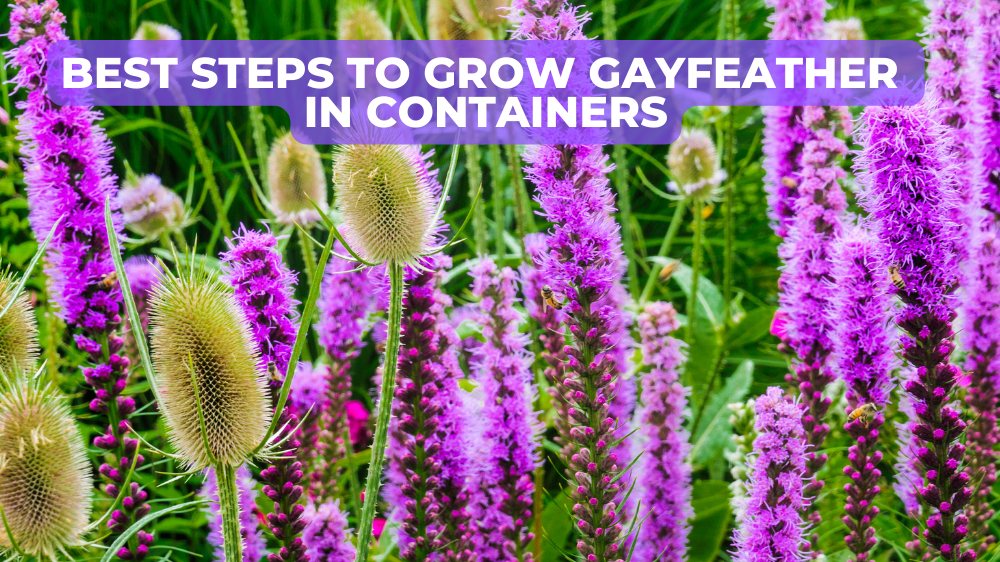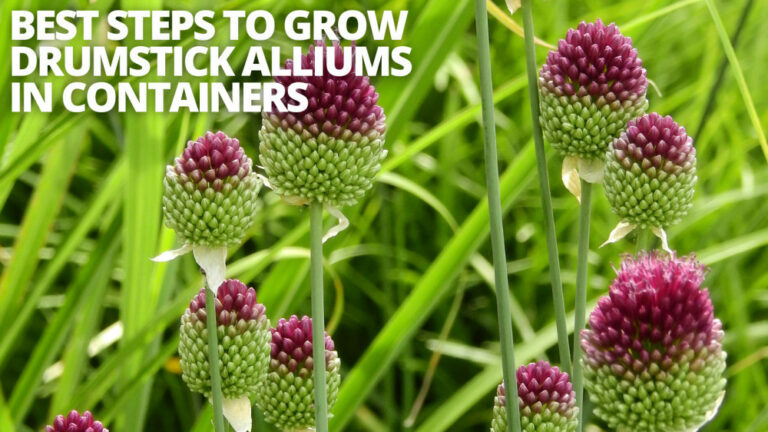Best Steps To Grow Gayfeather In Containers
Best Steps To Grow Gayfeather In Containers
The native perennial Liatris is well-known for its spiky, vivid purple bottlebrush flowers carried atop its thick, grass-like leaves and bloom in the late summer.
Although it thrives in gardens, prairies, and grasslands, Liatris may also be grown in pots. Yes, Liatris may be grown in pots. A display of Liatris plants in pots is breathtaking.
Please continue reading to learn more about growing gayfeather in containers and how to take care of them in pots.
History & Origin Of Gayfeather
A perennial member of the composite family called Liatris spicata bears the gayfeather (Asteraceae).
It grows naturally in the wild from Massachusetts and Minnesota to Mexico and is also known as Kansas gayfeather, thick blazing star, or Liatris.
A rough 6-foot (2-meter) stem of grass-like leaves forms the stem of the gayfeather. Purple and occasionally white flowers bloom in spikes ranging from 4 to 15 inches (10 to 38 cm).
North American native Liatris, sometimes known as gayfeather, is a genus of flowering plants in the Eupatorieae tribe of the Asteraceae family (Canada, United States, Mexico and the Bahamas).
Blazing Star is the name it is known by the most. Some species are employed as decorative plants and occasionally in flower arrangements. They are perennials and endure the winter as corms.
The larvae of various Lepidoptera species, such as the flower moths Schinia gloriosa and Schinia sanguinea, both of which feed only on the genus, as well as Schinia tertia and Schinia trifascia, use Liatris species as food plants.
Many nations plant Liatris spicata as a garden flower because of its eye-catching purple blossoms (pink or white in some cultivars).
Depending on their range, they bloom from July through August or September. It is known by various names when grown, such as button snakewort, Kansas gay feather, blazing star, and Liatris callilepis.
The plants require constant watering throughout the first growing season to establish deep roots, although they can tolerate shade and drought.
Plants can be purchased at garden centers or nurseries or produced from corms (similar to bulbs and tubers) or seeds.
Native Americans have historically employed the medicinal plant Liatris spicata for its expectorant, sudorific, stimulant, carminative, and diuretic qualities.
Along with these users, the Menominee used the herb for a “weak heart” and the Cherokee for pain in the back and limbs.
The root of the plant is the component most typically used. Additionally, Native Americans utilized the herb to cure edema, cramping, colitis, and snake stings.
Currently, the plant is utilized in potpourri, as a herbal insect repellant, and for sore throats by gargling an infusion.
Types Of Gayfeather
Typically, gayfeather blooms have purple tones. There are numerous Liatris species and cultivars with vivid pink or white blooms.
Other Liatris species include Aspera, pycnostachya, cylindrical, and ligulistylis and Liatris spicata. Gayfeather comes in a variety of sizes and distinct variety types.
While certain tall gayfeather plants are suitable for background flowers, other tall plants are perfect for planting in containers.
To grow gayfeather in containers, you must know about the best varieties.
1. Gayfeather ‘Alba’
In full sun, this white-flowered gayfeather shrub can reach heights of 3 feet (1 meter). The feathery white flower tufts that make up the gayfeather ‘Alba' flower spikes give the flower head a fuzzy appearance.
2. Gayfeather ‘Kobold’
The fluffy, conical, brilliant purple flower heads on the short bloom stalks of this clump-forming perennial are attractive. The tiny Gayfeather ‘Kobold' plant is perfect for cultivating in pots or small gardens.
3. Gayfeather ‘Floristan Weiss’
The large white flowering spikes on this tall gayfeather plant are attractive. Like all Liatris species, the brilliant, fluffy flowers have a thin conical shape and bloom from top to bottom.
4. Rough Blazing Star (Liatris aspera)
The Rough blazing star flower is a big pink tuft of feathery blossoms that grows on one of the tallest Liatris plants. The rough blazing star pink flower spikes can reach 5 feet (1.5 meters).
5. Dotted Gayfeather (Liatris Punctata)
The height of this lovely small gayfeather plant is only 2 feet (0.6 meters). Large tufts of flimsy flowers make up the pink gayfeather flower heads.
The spotted gayfeather plant grows well in containers, perennial borders, and rock gardens.
6. Prairie Blazing Star (Liatris Pycnostachya)
Another tall perennial flowering plant is the prairie blazing star. This variety of Liatris has flower spikes that resemble blazing stars and are either pink or purple.
The prairie blazing star has a height range of 2 to 5 feet (0.6 to 1.5 meters).
Benefits Of Gayfeather
Cutting off the top third of the plant with open buds is a good choice for cutting Blazing Starflower Liatris spikes for floral arrangements.
Leave the buds below the buds for your garden. Purple Liatris are also useful as dried flowers. Seek out flower spikes with fully blown flowers.
Cut off the entire flower spike, stem and all, from top to bottom. Finally, dry the stems and blossoms by hanging them upside-down in a room with indirect light and good ventilation.
5 Great Reasons For Making Gayfeather A Great Garden Addition
1. Space Efficiency
Liatris takes up a relatively small area in the garden, even though it can grow very tall. This makes it an excellent filler for voids and an excellent addition to containers and extremely compact gardens.
2. Function & Beauty
Shorter perennial flowers look stunning against the tall, vibrant Gayfeather blossoms. In the higher types, it also works well as a border or privacy barrier throughout the summer.
3. Fauna Friendly
Friendly wildlife in the garden benefits significantly from Liatris. Throughout the growing season, it draws pollinating insects like bees and butterflies. Seeds are a fantastic source of extra food for birds in the fall.
4. Drought Tolerance
Another great justification for picking Liatris for your garden is that it uses little water. The plant can withstand drought because its corms naturally store water that may be used when the weather is dry.
5. Easy To Grow
The Blazing Star is simple to grow if you have a location that receives bright, direct sunlight and well-drained soil.
The soil's low fertility is not a problem. In actuality, Liatris thrives on lean to moderate nutrition levels.
The plant is simple to grow and appears to be disease and insect-resistant. Additionally, the plant thrives in USDA zones 5 to 9.
Grow Gayfeather In Containers
Long-blooming perennial Liatris, often called blazing star or gayfeather, is a plant indigenous to eastern North America.
It belongs to the enormous aster (Asteraceae) plant family. Still, unlike most family members, Liatris has extremely distinctive flower heads with tiny star-shaped blossoms placed around a long, erect bottlebrush spire.
There are pink and white varieties in addition to the pure species' vivid purple flower spikes. The short, unnoticeable leaves resemble grass and grow in a basal clump.
Choose The Right Container
To plant Liatris in a pot or container, choose one at least one gallon in size (4 L). The Liatris may grow and bloom in larger containers.
The capacity of the example below is about 3 gallons (12 L). Stability also depends on the size. Liatris are frequently 2-3 feet tall.
The less probable the pot is to topple over, the larger or heavier the container. Selecting a big pot can aid in preserving stability.
Ensure the container has numerous sizable drain holes on the bottom to prevent water from accumulating.
This is because rotting roots will cause poor drainage to destroy Liatris. If the pot has no drainage holes, add some or choose another.
Location To Grow Gayfeather In Containers
The best site to put gayfeather bulbs (also known as corms) in your yard is in an area that receives lots of sunlight. Excellent drainage is a need for the planting site.
Wet weather can bring root rot, especially in the winter. Gayfeather can be grown in informal cottage gardens, mixed flower beds, and floral borders.
Black-eyed Susan and echinacea are tall flowering plants that make excellent gayfeather companions.
Gayfeather thrives next to ornamental grasses, daylilies, and other aster-related plants.
Soil To Grow Gayfeather In Containers
Gayfeather thrives in rich, fertile soil with good drainage that is consistently moist.
You can create the ideal ground conditions by incorporating plenty of peat moss and old compost to supply nutrients and preserve moisture.
You can also add grit or perlite to the soil to improve drainage.
Spike gayfeather is a perennial garden plant that thrives practically anywhere. The sturdy plant continues to grow and flower throughout the summer, even in poor, dry soil. However, when the soil conditions are optimal, the plant grows fastest.
To grow gayfeather well, keeping the roots from becoming saturated with water is essential.
Gayfeather plants emerge from moist tuberous corms. The plant will eventually die from root degradation from the excessively wet soil.
Watering
Gayfeather clumping plants only require occasional watering after they are established. The best action is to water the ground as frequently as needed to keep it from completely drying out.
In general, you can wait to thoroughly water the plant until the top 2″ (5 cm) of soil is dry. Give the spike gayfeather around 1″ (2.5 cm) of water per week throughout the scorching summer months.
Regular irrigation helps flowers grow slowly and minimizes leaf scorching. Gayfeather should only be watered on the ground, and the foliage should not be splashed with water.
The watering method protects against fungus-related leaf diseases, including powdery mildew. Gayfeather is a perennial that can withstand some drought after it has been established.
Liatris spicata may grow in dry situations even though it likes damp soil.
Temperature & Humidity
Cold-tolerant perennials that recur year after year are gayfeather plants. Gayfeather tuberous roots can resist temperatures as low as -40°F (-40°C) in USDA zone 3. If given ample water, Gayfeather thrives in the heat and direct sunlight during the summer.
Gayfeather plants hardly ever have a problem with humidity. It's crucial to ensure the plant has adequate space to spread.
Gayfeather has a 15″ maximum spread (38 cm). The plant's health is maintained by proper air circulation, which also stops fungal problems from harming the leaves.
Overwintering
Liatris doesn't require special protection from the winter cold when grown within its hardiness range.
Although you can leave the flower heads in place to provide food for wintering birds, the standard procedure is simply cutting the flower stalks off at ground level.
As Liatris dislikes wet winter soil, which could trap moisture and encourage bulb rot, do not pile mulch over the plant crowns for the winter. Make sure to remove any wet garden debris in the spring before new growth appears.
Fertilizing
If the soil is healthy, gayfeather blazing stars are not heavy feeders. You most likely don't need to add any fertilizer for the plant to grow well.
To promote abundant blooming all season long, you can use a high phosphorus water-soluble fertilizer in the spring.
Use fertilizer with an NPK grade of 5-10-5 if you choose to use it. You can also add some compost into the ground in the spring to increase the soil's nutritional content.
Pruning
The conical blooms of gayfeather bushes should only be removed after blossoming. Liatris plants produce more blossoms when the dead flowers are removed.
Sometimes, using this kind of pruning, gayfeather flowers continue to bloom into the fall.
Here is some helpful trimming advice for gayfeather plants:
- During the summer, remove faded blossoms to promote flowering.
- Once blooming has ended, you can clip the entire stalk at the plant's base.
- You can prune the plant throughout the growing season to eliminate dead leaves.
- Gayfeather stalks shouldn't be pruned in the fall. This promotes new growth that might cause winter harm.
- Cut down the foliage and flower stalks that have died once the gayfeather plant has fallen to the ground. Leave 4″ (10 cm) or so above the surface.
- Alternatively, you might leave the flowering grass unpruned all winter and cut it back in early spring.
Propagating
Gayfeather plants can be multiplied mainly through root division and seedling growth. Divided corms of Liatris spicata are simple to replant in aerated, well-draining soil.
Gayfeather seeds can also be gathered in the fall and planted in the ground after exposure to the cold.
Gayfeather plants can be easily multiplied in the spring by dividing their tuberous roots. You must gently remove the bulk of the bulbs from the ground first.
Cut the roots or break off infant corms using a sharp knife. There should be a few leaves on each corm.
Plant new gayfeather plants 12″ to 15″ (30 – 38 cm) apart from the bulb. Plant the bulbs 7.5 cm (3 inches) deep.
Gayfeather can be multiplied by seed. The seeds, however, take a long time to germinate and must be exposed to the cold.
Transplanting
Work in around 2″ (5 cm) of organic debris to the planting area before you plant gayfeather in your backyard. Improve drainage by amending the soil as necessary.
Create a hole twice as broad and a little deeper than the root ball. Fill the hole with dirt, insert the corm, and then thoroughly water.
When planting them in your garden, it is preferable to space gayfeather bulbs 12″ to 15″ (30 – 38 cm). Leaving plenty of space between grassy plants allows air to flow freely, preventing numerous leaf fungal diseases.
Until they become established, gayfeather plants need to be regularly watered. The good news is that gayfeather grows quickly and typically blooms in the first season following planting.
Pests & Diseases Of Gayfeather
Liatris species plants typically have high pest resistance. However, caterpillars are typically the largest danger to gayfeather plants.
The blooms and occasionally the stems are consumed by the larvae of the Liatris borer moth (Carmenta anthracipennis), rare brilliant flower moth (Schinia gloriosa), and Liatris flower moth (Schinia sanguinea).
Picking them by hand is the most effective method for removing caterpillars on gayfeather plants. You can also spray the plants with water to remove hungry, plant-eating caterpillars.
Powdery mildew, leaf spot, and root rot are common ailments that harm gayfeather plants. It's critical to provide sufficient air circulation and watering to prevent plant illnesses.
The tuberous corms deteriorate in overly wet, soggy conditions. Fungal infections may eventually begin to damage the roots.
Try to avoid splashing water on the leaves when watering gayfeather plants. Dampness on leaves can lead to the spread of fungi and other infections on the foliage.
As a result, the leaves may develop a darker patch or a powdery white covering (powdery mildew) (leaf spot).
Ensure adequate air circulation since this is another method of preventing fungal illness. The ideal distance between gayfeather plant bulbs is 12″ (30 cm).
The plant develops and spreads more over time. Thus, the division is required every few years to thin the plant's growth.
Conclusion
Gayfeather ornamental flowers look lovely in arrangements of fresh-cut or dried flowers. Freshly cut gayfeather flowers can last up to two weeks in a vase of water.
Gayfeather flowers can be dried as well to extend their blooming period. To dry the flowers, hang them upside-down in a dim, dry location for three weeks.
I trust you enjoyed this article on the Best Steps To Grow Gayfeather In Containers. Please stay tuned for more blog posts to come shortly. Take care!
JeannetteZ
>>>Please click here to read my all-inclusive article about Container Gardening<<<
>>>Are you interested in homegrown herbs and medicine? Please click here to find out more about it!<<<
Your Opinion Is Important To Me
Thoughts? Ideas? Questions? I would love to hear from you. Please leave me your questions, experience, and remarks about this article on the Best Steps To Grow Gayfeather In Containers in the comments section below. You can also reach me by email at Jeannette@Close-To-Nature.org.
Disclosure
This post may contain affiliate links. As an Amazon Associate and other affiliate programs, I earn from qualifying purchases at no extra cost to you. Read my full affiliate disclosure.
You might also enjoy these blog posts:
Best Steps To Grow Yarrow In Containers
Best Steps To Grow Conebushes In Containers
Best Steps To Grow Curry Plants In Containers
Best Steps To Grow Viola In Containers
Best Steps To Grow Parsnips In Containers


























